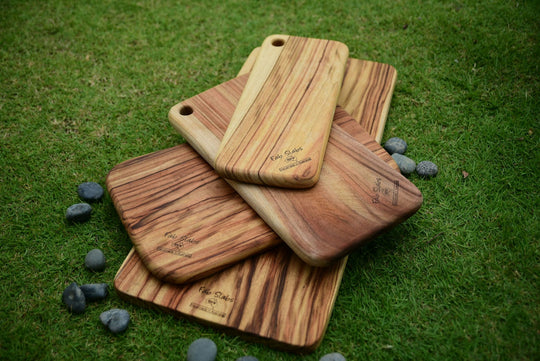A Beginner's Guide to Choosing the Right Wood for Boards
Posted on May 04 2025,

Choosing the right wood for cutting boards is like setting the foundation for a home. A good base ensures durability and functionality. Whether you're a newbie or an experienced cook, understanding your options helps you select a board that aligns with both your cooking style and your kitchen decor.
Customized cutting boards add a personal touch to your kitchen, allowing you to engrave meaningful memories like family recipes or special notes. These boards are not only functional but also provide a way to keep memories alive in everyday life. Plus, starting with the right wood type makes all the difference in creating a board that stands the test of time.
Understanding Different Types of Wood
Different woods offer unique benefits, each bringing something special to your culinary space. Here are some commonly used woods for cutting boards and what they bring to the table:
- Maple: Known for its strength, maple is a dense wood that resists scratches and dents. Its subtle grain and light color make it an attractive choice for many kitchens.
- Walnut: This wood stands out with its dark and rich appearance. Walnut is slightly softer than maple but still offers good durability. Its traditional look adds elegance, making it a favorite for those wanting a touch of sophistication.
- Cherry: Cherry wood adds warmth with its reddish tones. It grows darker and richer over time with exposure to light, giving your board a unique, aged look. It’s less dense than maple and walnut, but still holds up well with proper care.
Each type of wood has its own strengths, so choosing one depends on what matters most to you. Whether you prefer the resilience of maple, the rich beauty of walnut, or the warm glow of cherry, these choices offer durability and style. Wood selection also impacts how your board interacts with your knives. Softer woods might be gentler on edges, while harder woods typically withstand heavy use better. Keep in mind that a well-chosen wood helps maintain a balance between board longevity and kitchen aesthetics.
Factors to Consider When Choosing Wood
When selecting the right wood for cutting boards, several factors come into play. Let's break them down:
1. Durability and Longevity: Different woods have different hardness levels, which impact how long they last. Harder woods like maple are more resistant to cuts and dents, making them ideal for frequent use. On the other hand, softer woods like cherry can get scratched more easily but often heal over time.
2. Ease of Maintenance: Some woods are less porous, which means they absorb less moisture and resist stains, making them easier to clean and maintain. Maple is a top choice for those who want minimal upkeep.
3. Aesthetic Appeal: The look of your board matters too. Consider the color and grain patterns of each wood. Walnut, with its deep brown tones, adds a classy touch, while the warm reds of cherry offer a cozy vibe. The style and look of the board should blend well with your kitchen’s personality, contributing to the room’s overall feel.
By weighing these factors, you can make a choice that fits your needs and ensures your board complements your cooking habits.
Customization Options for Cutting Boards
Personalizing a cutting board transforms it from a simple kitchen tool into a meaningful piece of art. Here are some popular customization features:
- Engraving Family Recipes: Capture grandma's famous cookie recipe forever on your board. Custom engravings align with the original handwriting, preserving the sentiment behind these cherished words.
- Notes and Signatures: Add a personal touch by engraving a heartfelt note or the signature of a loved one. These small additions turn your board into a memento.
- Domestic Hardwoods: Choosing domestic wood ensures quality and sustainability. Woods sourced from the USA are renowned for their superior craftsmanship and ethical sourcing. These boards not only add uniqueness but also promise lasting durability.
These options make your board not just a kitchen accessory but a keepsake that holds personal significance and aesthetic beauty.
Tips for Maintaining Your Custom Cutting Board
Taking care of your personalized cutting board ensures it stays beautiful and functional for years. Here are some maintenance tips to keep in mind:
- Cleaning: Wash your board with warm, soapy water right after use. Avoid soaking it in water to prevent warping. Simply wipe it down for best results.
- Oiling: Regular oiling helps keep the wood hydrated and prevents it from drying out. Use food-grade mineral oil or beeswax, applying a thin layer once a month or whenever the board looks dry.
- Avoiding Excessive Heat and Moisture: Keep the board away from direct sunlight and never use it as a trivet for hot pots. Both situations can damage the wood and reduce its lifespan.
By following these easy steps, you maintain the board’s strength and appearance, ensuring it continues to be a cherished part of your kitchen ritual.
Bringing It All Together
Choosing the right wood, understanding your customization options, and knowing how to maintain the board combine to create a valuable kitchen tool. These cutting boards become more than just functional items; they are also rich with memories and personal stories. Personalizing your kitchen space with a tailored board adds both beauty and practicality to your cooking experience, while preserving the sentimental value that makes a house feel like home.
Bring your kitchen to life with personalized touches that make your cooking space truly unique. Explore how customized cutting boards can add warmth and sentiment, combining practicality with lasting memories. Discover more about our offerings and how you can feature cherished recipes or notes on beautifully crafted boards by visiting Recipeboard.com.
